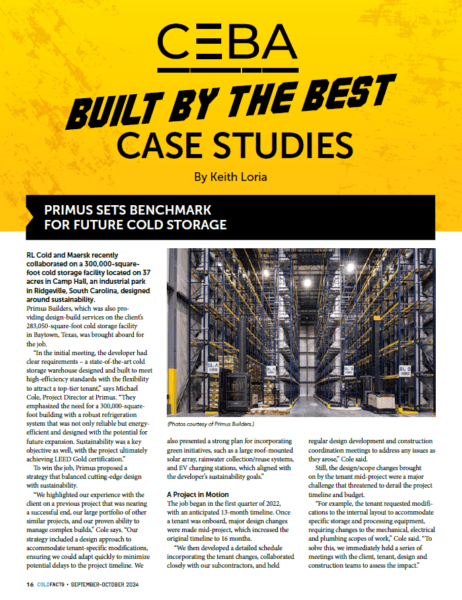From COLD FACTS Magazine (Click Image)
Read Below:
CEBA Built by the Best Case Studies
Primus sets benchmark for future cold storage & Ti Cold Partners With Sierra Supply Chain to Launch Cutting-Edge Facility in Ontario.
By Keith Loria
PRIMUS SETS BENCHMARK FOR FUTURE COLD STORAGE
RL Cold and Maersk recently collaborated on a 300,000-squarefoot cold storage facility located on 37 acres in Camp Hall, an industrial park in Ridgeville, South Carolina, designed around sustainability.
RL Cold and Maersk recently collaborated on a 300,000-squarefoot cold storage facility located on 37 acres in Camp Hall, an industrial park in Ridgeville, South Carolina, designed around sustainability.
“In the initial meeting, the developer had clear requirements – a state-of-the-art cold storage warehouse designed and built to meet high-efficiency standards with the flexibility to attract a top-tier tenant,” says Michael Cole, Project Director at Primus. “They emphasized the need for a 300,000-squarefoot building with a robust refrigeration system that was not only reliable but energy efficient and designed with the potential for future expansion. Sustainability was a key objective as well, with the project ultimately achieving LEED Gold certification.”
To win the job, Primus proposed a strategy that balanced cutting-edge design with sustainability.
“We highlighted our experience with the client on a previous project that was nearing a successful end, our large portfolio of other similar projects, and our proven ability to manage complex builds,” Cole says. “Our strategy included a design approach to accommodate tenant-specific modifications, ensuring we could adapt quickly to minimize potential delays to the project timeline. We also presented a strong plan for incorporating green initiatives, such as a large roof-mounted solar array, rainwater collection/reuse systems, and EV charging stations, which aligned with the developer’s sustainability goals.”
A Project in Motion
The job began in the first quarter of 2022, with an anticipated 13-month timeline. Once a tenant was onboard, major design changes were made mid-project, which increased the original timeline to 16 months.
“We then developed a detailed schedule incorporating the tenant changes, collaborated closely with our subcontractors, and held regular design development and construction coordination meetings to address any issues as they arose,” Cole said.
Still, the design/scope changes brought on by the tenant mid-project were a major challenge that threatened to derail the project timeline and budget.
“For example, the tenant requested modifications to the internal layout to accommodate specific storage and processing equipment, requiring changes to the mechanical, electrical and plumbing scopes of work,” Cole said. “To solve this, we immediately held a series of meetings with the client, tenant, design and construction teams to assess the impact.”
Balancing the needs of both the client and the tenant, while navigating the challenges of material escalations, labor shortages, incredibly long permitting and inspection timelines created a highly stressful and dynamic environment. Facing these challenges in conjunction with the project’s complexity and high sustainability standards made it unique.
By thoroughly investigating all aspects of each change, and collaborating with subcontractors, the Primus team was able to develop a full understanding of how each trade was affected from a cost and schedule aspect.
“As such, our contract amount and schedule were adjusted accordingly,” Cole says. “We then fast-tracked the approval of revised plans and worked closely with our suppliers and subcontractors to expedite. We had a pull-planning session with all subcontractors on-site to get their buy-in on scope, duration and timing. To top it all off, we also encountered multiple material shortages and cost escalations, force majeure notices and subcontract labor shortages during this time, but we got through it.”
Innovative Design
Cooling the building is a state-of-the-art Ammonia-CO2 Cascade system, which utilizes rainwater, captured and stored onsite in a 50,000-gallon tank to cool the condensers during peak demand. This resulted in a 30% gain in energy efficiency.
Other innovative design highlights include implementation of a Very Narrow Aisle (VNA) racking system, F-min 85 flat floors, advanced energy monitoring and an automated de-slatting system/conveyor line.
Sustainable Measures
To achieve its LEED Gold designation, the Ridgeville cold storage facility has numerous sustainability features.
“This project demonstrates a 32% improvement in energy performance,” Cole said. “This was achieved by incorporating the rainwater capture system, a tight and efficient thermal envelope, highly efficient LED lighting, an advanced energy monitoring system and a 1-megawatt rooftop solar array that back feeds to the energy grid offsetting a portion of the buildings overall energy costs. We also installed electric vehicle (EV) charging stations in the parking area to promote the use of green transportation.”
Cole feels achieving LEED Gold was the biggest accomplishment of the job, though he’s also particularly proud of how the entire Primus team managed to incorporate the lastminute changes in conjunction with balancing the expectations and needs of both the client and the tenant as well.
“The team demonstrated a steadfast adaptability throughout the project,” Cole says. “It was an environment of open communication, where every member—from the design team to the subcontractors—was encouraged to contribute ideas and solutions. This was not by accident, It was because each of us knew that it was the only way to pull this off successfully. The team’s ability to work together, pivot quickly and stay focused on the end goal was critical to our success.”
A Job Well Done
For Cole, one aspect that stands out to him about the finished project is the way the facility has set a new benchmark for future developments in the cold storage industry.
“The integration of advanced green technologies with the specialized requirements of cold storage is not something you see every day,” he says. “It’s a testament to what can be achieved when all stakeholders are committed to innovation and sustainability. This project wasn’t just about building a warehouse; it was about creating a facility that meets today’s environmental standards and challenging the rest of the industry to do more green cold facilities.”
TI COLD PARTNERS WITH SIERRA SUPPLY CHAIN TO LAUNCH CUTTING-EDGE FACILITY IN ONTARIO
Sierra Supply Chain Services, a full-service cold chain provider, wanted a 164,000-square-foot expansion to its existing processing facility in Hamilton, Ontario, Canada, and called on long-term partner Ti Cold for the job.
“We met the owners four years before we even started this project,” says Rob Adams, Executive Vice President and Partner at Ti Cold. “Originally, it was a small addition, but that led to a very large addition.”
The $65 million project added 36,000 pallet positions, and brought the facility to a grand total of 250,000 square feet, including 30,000 square feet of food processing space in a 65-foot-tall building.
From the beginning, it was clear Sierra was looking for an innovative temperature-controlled facility with efficiency in mind.
“Innovation is the name of the game for this Ti Cold build,” Adams says. “Pushing boundaries, outside-the-box problem solving, and dedication in the face of one obstacle after another, we successfully master planned and constructed this expansion.”
Innovative Ideas
From the outset, because Sierra was limited on space due to where the facility was located, Ti Cold was tasked to maximize the footprint. It ended up building a two-deep, 65-foot-tall very narrow aisle, which was the first in North America that had that narrow an aisle with a push-back racking system.
Ti Cold also exceeded expectations by making Sierra the first in Ontario – and only the second in all of Canada – to use an Evapcold packaged approach for refrigeration systems.
In doing so, Ti Cold collaboratively engineered an intricate and fully customized master control system that operates all the packaged refrigeration equipment. It allows the customer to take advantage of energy management features such as load shedding, on-peak and off-peak management, run time management, etc. This is to accommodate Canada’s IESO utility rate program, which incentivizes large consumers to reduce power or come offline during specific time windows.
“Ti Cold went the extra mile by creating inventive energy solutions and investing hours into detailed energy saving outcomes, which gained Sierra the largest to-date rebate from the Canadian Government Utilities Program, resulting in a seven-figure savings,” Adams says. “In addition, due to our package approach, the facility outperformed the nation’s strict operation standards and was granted a modified manpower requirement, eliminating 24/7 coverage and saving Sierra Supply Chain hundreds of thousands in operation costs.”
The builder also combined very narrow aisles, extended ceiling heights and added two deep push-back RBI racking to maximize density, decrease the total footprint, and increase storage capacity to 3.5 times the pallets per square foot.
“We had a dedicated room that we used for blast freezing, so we were doing things a little bit different,” Adams said. “We had a whole separate refrigeration system that we utilized for the blasting, which was very unique from the rest of the building.”
The cooler rooms were split between one larger cooler, set at 34ºF, and one smaller 28ºcsuper chill cooler.
“Maintaining exactly 28°F is the perfect temperature for Sierra’s product and required us to specially engineer equipment in order to operate in only plus/minus 1.5 degrees (super low Delta T) as opposed to standard coolers, which range from 38-34°F,” Adams says.
All processing areas, including both slabs and curbs, are equipped with a durable troweled resinous floor coating, stainless steel floor and slot drains. Each room features custom built stainless steel racks designed to support hot high-pressure water lines, compressed air lines, and multiple sanitizing lines.
Moreover, all processing spaces include galvanized structural steel and a suspended, walkable insulated panel ceiling, which enables utility piping to be conveniently installed in the interstitial space. The seams of all panels are sealed using USDA/CFIA-compliant sealants, and all doors in these areas are process-rated. This includes insulated fiberglass doors from Global Insulated Doors, Inc. and “clean” high-speed doors from Rite Hite.
Sustainability Matters
Ti Cold also thought a lot about efficiency and sustainability within the job.
For instance, it installed Variable Frequency Drives on most of the compressors and evaporator fans to take advantage of cube-root savings.
“This helps us control capacity requirements on a linear scale, not just stop/start, which is hard on the motors,” Adams says.
To meet the demanding requirements of temperature, pressurization, air purity, humidity and condensation control, the processing and production spaces also received state-of-the art systems.
A waste heat floor heating system was installed in the process space to reduce floor condensation and wetness, improving operational safety; sloped floors with stainless steel slot floor drains were added to make clean-up easier for processing room employees; and there was a great deal of interstitial space included in the design, allowing for a cleaner production room.
“To meet the requirements of a third-party freezing provider for a local customer with a large variety of products, a new Quick Freeze System with much greater automation capability was installed,” Adams said. “This enabled a 13-minute process taking fresh product from a 45°F, 100% humidity processing room to an -18°F, 25% humidity blast freezing room, generating significant infiltration reduction.”
Additionally, Sierra’s choice to use Evapcold Low Charge Ammonia Systems resulted in a substantial reduction of ammonia on site.
Overcoming Challenges
Once the contract was signed to begin the project, COVID came, so that resulted in some immediate challenges.
“We couldn’t get people across the border and when we did, they had to isolate for two weeks, so we designed the whole building with the owners, over a year, via Zoom,” Adams says. “It was tedious with the installation of racking, fire protection, lighting and electrical because of the narrow-aisle format.”
One of the limiting factors of the project was the material handling equipment as the VNA racking system required extreme tolerances, with less than 3-feet of clearance between each side of the TSP truck and the face of racking.
Super-flat Fmin 100 slabs were required to support Crown’s TSP Turret fork truck, used to pick pallets from 60-feet-tall racking.
Due to the heights of this facility, normal integrated sensors on the fixtures wouldn’t work.
“We had to then integrate remote motion sensors within the racking in each aisle to maintain the same efficient lighting system,” Adams says.
Plus, network signals are blocked because of the height and density of the racking, Ti Cold assisted Sierra in designing the complex infrastructure required to have reliable coverage within this state-of-the-art freezer.
“We had weekly, and sometimes almost daily calls—they were way involved more than most clients are, and we had great collaboration throughout,” Adams says.
The Final Word
The job was completed on-time and on budget, and Rob Vanden Broek, CEO of Sierra Supply Chain Services, praised Ti Cold for a job well done.
“We were excited to bring this state-of-the- art facility to market,” he says. “High density and high efficiency are the future in 3PL supply chain and Sierra Cold will lead the way.”
Adams called the day the facility opened, a happy day for all involved.
“Everything worked as we designed it, so that was very gratifying for them and us,” he says. “It worked the way we said it would.”




